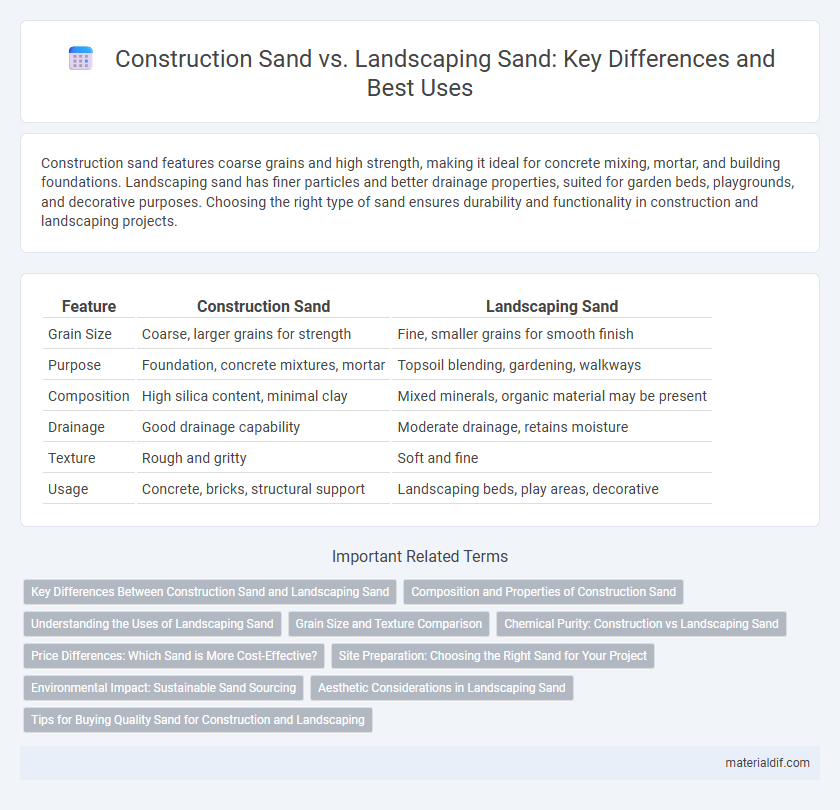Construction sand features coarse grains and high strength, making it ideal for concrete mixing, mortar, and building foundations. Landscaping sand has finer particles and better drainage properties, suited for garden beds, playgrounds, and decorative purposes. Choosing the right type of sand ensures durability and functionality in construction and landscaping projects.
Table of Comparison
| Feature | Construction Sand | Landscaping Sand |
|---|---|---|
| Grain Size | Coarse, larger grains for strength | Fine, smaller grains for smooth finish |
| Purpose | Foundation, concrete mixtures, mortar | Topsoil blending, gardening, walkways |
| Composition | High silica content, minimal clay | Mixed minerals, organic material may be present |
| Drainage | Good drainage capability | Moderate drainage, retains moisture |
| Texture | Rough and gritty | Soft and fine |
| Usage | Concrete, bricks, structural support | Landscaping beds, play areas, decorative |
Key Differences Between Construction Sand and Landscaping Sand
Construction sand features larger, coarser grains primarily used for concrete, mortar, and paving projects, offering superior strength and stability. Landscaping sand has finer, smoother particles that improve soil drainage and weed control, enhancing garden and lawn aesthetics. The key differences lie in grain size, texture, and intended application, affecting performance in structural support versus soil conditioning.
Composition and Properties of Construction Sand
Construction sand consists primarily of coarse, angular grains of quartz and feldspar, providing excellent load-bearing capacity and stability for concrete and masonry applications. Its high silica content and rough texture enhance adhesion to cement, making it essential for structural integrity in building projects. This type of sand is free from organic matter and fine particles, ensuring durability and strength in construction materials.
Understanding the Uses of Landscaping Sand
Landscaping sand, characterized by its coarse texture and excellent drainage properties, is ideal for improving soil aeration and facilitating water runoff in garden beds and pathways. Unlike construction sand, which is finer and primarily used for concrete mixing and masonry work, landscaping sand enhances soil structure and supports plant health by preventing soil compaction. Its uses extend to leveling lawns, filling paver joints, and creating stable bases for outdoor features, making it essential for effective landscape design.
Grain Size and Texture Comparison
Construction sand typically features coarser grains ranging from 0.5 to 2 millimeters, providing better compaction and strength for concrete and masonry work. Landscaping sand consists of finer, smoother grains often less than 0.5 millimeters, ensuring improved drainage and a more refined surface for garden beds and walkways. The texture difference impacts water retention and compaction properties, making grain size and roughness critical factors in selecting the appropriate sand type for specific projects.
Chemical Purity: Construction vs Landscaping Sand
Construction sand typically exhibits higher chemical purity with minimal organic impurities, ensuring optimal strength and stability in concrete mixtures. Landscaping sand may contain varying levels of clay, silt, and organic matter, affecting its chemical composition and permeability in garden beds or pathways. The chemical purity of construction sand is crucial for structural integrity, while landscaping sand prioritizes drainage and soil amendment properties.
Price Differences: Which Sand is More Cost-Effective?
Construction sand typically costs more due to its higher purity and specific granule size, which ensures strength and durability for structural projects. Landscaping sand is often less expensive as it is coarser and less processed, primarily used for aesthetic and drainage purposes. For budget-conscious projects requiring high structural integrity, investing in construction sand proves more cost-effective despite the higher price per ton.
Site Preparation: Choosing the Right Sand for Your Project
Construction sand, characterized by its coarse texture and angular grains, provides superior compaction and drainage, making it ideal for site preparation in building foundations and concrete mixes. Landscaping sand, often finer and smoother, enhances soil aeration and promotes healthy plant growth, suited for garden beds, lawns, and decorative pathways. Selecting the appropriate sand based on its grain size and permeability ensures structural stability for construction sites and optimal soil conditions for landscaping projects.
Environmental Impact: Sustainable Sand Sourcing
Construction sand typically undergoes rigorous extraction processes, often leading to habitat disruption and increased carbon emissions due to heavy machinery use. Landscaping sand, sourced from less intensive mining areas or recycled materials, generally has a lower environmental footprint and supports sustainable land management practices. Choosing sustainably sourced sand minimizes ecosystem damage, preserves biodiversity, and promotes responsible resource utilization in both construction and landscaping projects.
Aesthetic Considerations in Landscaping Sand
Landscaping sand features finer grains and a uniform texture, enhancing visual appeal by creating smooth, clean surfaces ideal for garden pathways and decorative beds. Its natural color variations complement plantings and outdoor designs, contributing to a cohesive and attractive landscape aesthetic. Unlike coarser construction sand, landscaping sand minimizes harshness and provides a softer, more inviting appearance in exterior spaces.
Tips for Buying Quality Sand for Construction and Landscaping
Construction sand must have angular grains for strong bonding in concrete, while landscaping sand requires smoother texture for aesthetic appeal and better drainage. Select sand free of contaminants like clay, silt, and organic matter to ensure durability and performance. Purchasing from reputable suppliers with certified testing reports guarantees consistent quality tailored to specific construction or landscaping projects.
Construction Sand vs Landscaping Sand Infographic

 materialdif.com
materialdif.com